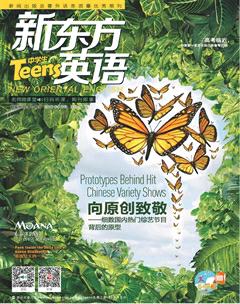斑点胡:一个长“雀斑”的湖
A short ride northwest of the small Canadian town of Osoyoos there is a body of water which has come to be known in English as Spotted Lake. It is believed to be the most mineralized2) lake on the planet with 365 "circles"—one for each day of the year—in a large number of shapes, sizes and depths. It is an extraordinary natural phenomenon.
It is called Kliluk by the Okanagan, one of the native peoples in Canada collectively called the First Nations3).For them, it is a sacred medicine lake and their people have been coming to the lake in search of cures for various ailments4) for centuries. There are hundreds of ceremonial cairns5) surrounding the lake, many of which are so old that they have been buried by time.
The Okanagan used the lake as a spa, in effect, soaking away their aches and pains in its healing waters. One story in their oral history has a battle between tribes coming to a halt6) and a truce7) being called so that both sides could tend their wounded in the lake.
As the heat of the summer rises, most of the water in the lake evaporates which leaves behind large mineral deposits8), easily visible with the naked eye—the spots for which the lake is so famous. They appear different in color because of their various mineral compositions. They are mainly made of magnesium sulfate9)—popularly known as Epsom salts10)—which crystallize in the summer. It is said that the lake has the highest natural concentration of this mineral in the world.
During the driest periods of the year the lake is without any liquid at all. The area around the spots could be walked through—although this is strictly forbidden. Yet what little there may be is sometimes tasted by the local wildlife. It is doubtful whether this bear's thirst was satisfied by these waters, however.
Even when it's coldest in the winter you can almost make out, through the snow, the dimples11) which form the circles.
The lake also has high concentrations of both calcium and sodium12) sulfate as well massive levels of eight other minerals. Furthermore, it contains both silver and titanium13). It must have been annoying for the Okanagan then, when during the First World War these materials were taken from the lake in large quantities in order to manufacture munitions14) for the largest military conflict the world had ever seen up to that point. Rather than being used for healing, they were used to help kill.
Little wonder then, that the First Nations have since then been keen to both preserve and own the land and the lake. Yet that did not happen for many years. The last owners of European descent, the Smith family, were reluctant to sell, wishing instead to make the lake into a spa. Finally, in 2001 a deal was made when the family abandoned their hold on the lake and the land around it and Spotted Lake returned to its original guardians.
As the site is both culturally and ecologically sensitive the lake and its surrounding areas are protected. At the moment the lake is fenced but it is hoped that there will eventually be an information kiosk15) and a fully developed lookout point from which interested tourists can view the lake without interfering with its delicate16) natural balance and the historic, sacred cairns of the Okanagan which are beyond valuation.
從加拿大小镇奥索尤斯开车出发,往西北方向行驶不远处有一片水域,它已逐渐以英文名“斑点湖”而为人所熟知。人们认为此湖是地球上所含矿物质最为丰富的湖泊,湖面散布着365个形状、大小和深度各异的“圆圈”(一个圆圈对应着一年的一天)。它是一处非同寻常的自然景观。
欧肯纳根人是被人统称为“第一民族”的加拿大原住民中的一支,他们称此湖为“克里卢克”。对他们而言,这是一个可以寻医问药的圣湖,几百年来,他们的族人一直会来这里寻求治疗各种疾病的办法。该湖四周有数百个用于仪式的堆石标,很多年代太过久远,经过多年已经被掩埋。
欧肯纳根人其实是把这个湖用作矿泉疗养地,他们泡在具有治愈功效的湖水里,来浸除疼痛。他们的口述历史中流传着这样一个故事:过去部落之间曾发生过一场战斗,双方打了一阵后停了下来,宣布休战,好让双方都能在湖中为自己的伤员疗伤。
随着夏天气温上升,大片湖水就会蒸发,留下大量用肉眼就能轻易看见的矿物沉淀,从而形成了为该湖赢得盛名的“斑点”。这些斑点因其所含矿物成分多种多样,呈现出不同的颜色。湖中的矿物质主要由硫酸镁(俗称泻盐)构成,它们一到夏天就会结晶。据说该湖硫酸镁的天然含量是世界最高的。
在每年最干燥的时期,湖水就会彻底干涸,这时人们可以徒步穿过“斑点”周围的区域,尽管此举被严格禁止。不过,就算可能会剩下一丁点湖水,它们有时也会被当地的野生动物尝上几口。至于这点湖水能否让图中这只熊止渴,那就很难说了。
即便是在隆冬季节,你也几乎可以透过积雪辨认出形成“圆圈”的那一个个小坑。
湖水还富含硫酸钙、硫酸钠以及其他八种含量极高的矿物质。除此之外,湖水中还含有银和钛。第一次世界大战期间,这些矿产被人们从湖中大量开采来制造军火,供这场在当时来说前所未见的世界最大军事冲突使用。这件事在当时肯定令欧肯纳根人感到恼火——湖中的矿产被用来帮助杀人,而不是治病救人。
难怪“第一民族”自此之后一直热衷于保护这片土地和这个湖,并渴望获得它们的所有权。然而,这个愿望多年来一直未能实现。史密斯家族是该湖的最后一代所有人,这个祖籍欧洲的家族并不愿将该湖售出,反而想把它打造成一个矿泉疗养地。最终在2001年才达成了一项协议,史密斯家族放弃了对该湖及其周边土地的所有权,斑点湖重新回到了其原先守护者的怀抱。
由于该地文化和生态环境脆弱,湖区及其周边地区都受到了保护。湖区目前围了护栏,不过希望这里最终会建一个信息亭和一个设施完善的 望台,感兴趣的游客可以由此欣赏湖景,而不会破坏这里脆弱的生态平衡以及欧肯纳根人那些极具历史意义的神圣堆石标,它们可是无价之宝。

